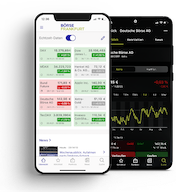Bonds: “Tariffs and Gaza proposal have led to uncertainty”

Reassurance, yes, but especially on the stock market. While concerns about Trump's course on tariffs and Gaza seem to have faded for equities, uncertainty still prevails on the bond market.
7 February 2025 FRANKFURT (Börse Frankfurt). The stock markets - especially in Germany - are in a party mood, with a new all-time high in early trading. On the bond markets, however, concerns about Donald Trump's policies are certainly reflected. Yields have fallen again compared to the previous week, while German Bunds and US Treasuries, which are considered safe, are in demand.
“Among other things, the decisive factor was probably the tariffs threatened and in some cases introduced by Trump, which reduced risk appetite and further increased concerns about the European economy,” explains bond analyst Hauke Siemßen from Commerzbank. ICF trader Arthur Brunner also points to the tariffs and Trump's Gaza proposal, i.e. to resettle the Palestinians and establish Gaza as the “Riviera of the Middle East”. “That has led to uncertainty.”
Ten-year German government bonds were yielding 2.36 percent at midday on Friday, down from 2.48 percent a week ago. In mid-January, it was still over 2.62 percent. In the USA, it is currently 4.43 percent after 4.53 percent last Friday.
Uncertainty depresses risk appetite
Signals about the further development of US key interest rates are expected from the US labor market figures this afternoon and the latest US inflation figures due next Wednesday. “Overall, the bond market in Europe can hardly hope for a tailwind due to the labor market report and the inflation data from the US,” explains Siemßen. He assumes that yields will establish themselves in their new - lower - trading range. This is because the gloomy growth prospects and uncertainty regarding US trade policy would probably continue to depress risk sentiment. “This is typically reflected in falling yields on German government bonds, which are considered safe.”
German long-dated bonds in demand - and Turkish lira bonds
Overall, bond trading is rather quiet at the moment. “Bonds are overshadowed by equities,” notes Brunner. He is seeing a lot of buying for a long-dated German government bond maturing in 2048 with a coupon of 1.25 percent and a current yield of 2.58 percent (DE0001102432).
According to Gregor Daniel from Walter Ludwig Wertpapierhandelsbank, there is still a lot going on in Turkish lira bonds, for example from the Asian Development Bank maturing in 2028 (XS2840132802) with purchases and the European Bank for Reconstruction and Development maturing in 2036 (XS2795696108) with purchases and sales. Yields currently stand at 30 and 34 percent respectively. The inflation rate in Turkey has been falling since last summer, but was still at 42% in January.
Lufthansa and Fresenius are popular
Well-known names continue to be popular in corporate bond trading. According to Daniel, the Lufthansa bond maturing in 2028 (XS2892988275), which currently yields 2.97 percent, is in demand, as are Fresenius bonds maturing in 2030 and currently yielding 2.78 percent (XS2482872251). Some short-dated bonds are also being sold, albeit not on a large scale. “This could be a shift into equities, gold or cryptocurrencies, there is no other explanation,” says the trader. One example: the SAP bond (<DE000A14KJF5>), which matures on 27 March.
New Nordic bond from SGL
There was a lot going on on the primary market this week, as Brunner reports. IBM came to the market with bonds in euros and US dollars, with different maturities but high minimum investment amounts. In contrast, the denomination of a new Nordic bond from SGL Group maturing in 2031 (NO0013469957) is 1,000 euros, as Brunner reports. “We are already seeing the first purchases.” Nordic bonds are a special form of corporate bond, which are usually subject to Norwegian or Swedish law. Special, largely standardized documentation has been developed for them. They also usually have variable interest rates.
In the case of government bonds, according to Brunner, one tranche with a term of five years and a coupon of 5.25 percent (XS2999533271), the other with nine years and 6.25 percent (XS2999552909) came onto the market. Minimum investment amount here too: 1,000 euros.
By Anna-Maria Borse, 7 February 2025, © Deutsche Börse
About the Author
Anna-Maria Borse is a financial and business editor specializing in the financial market/stock exchange and economic topics.
Feedback and questions to redaktion@deutsche-boerse.com





